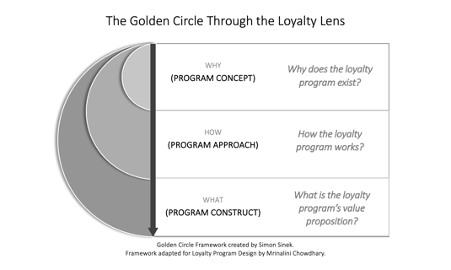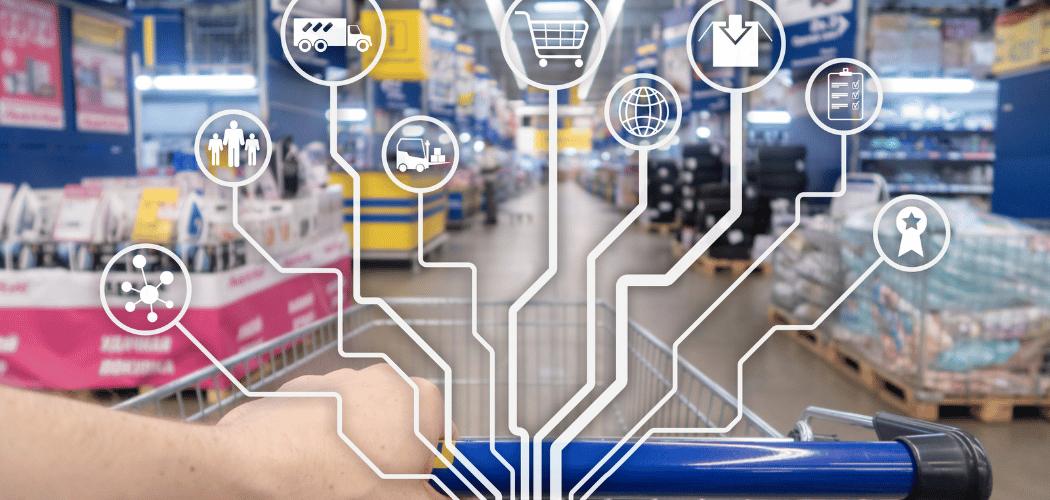By Mrinalini Chowdhary, CLMP™
Director, Strategy & Insights, Epsilon EMEA
In today's fiercely competitive marketplace, I find myself constantly on the lookout for innovative strategies to foster customer loyalty and set brands apart from the crowd. Among the gamut of approaches available, one framework that particularly resonates with me is Simon Sinek's Golden Circle.
As we delve into the core principles of the Golden Circle - the "why," "how," and "what" - and apply them to designing a loyalty program, we will uncover a flow to conceptualizing, orchestrating, and developing a compelling value proposition.
We know that loyalty programs are more than just a means to drive repeat purchases: they are platforms for creating meaningful and enduring relationships with customers. And yet, when we begin designing a program, we jump the gun and dive straight into the ‘how.’ I.e., the program approach, and the ‘what’ i.e., the value proposition. We need to take a step back and think of the ‘why’ i.e., the concept of the program and why it exists.
At its essence, the Golden Circle has challenged me to articulate the “why”: the purpose of a brand’s program needs to propel the brand’s overall mission in a way that deeply resonates with their target audience. In this article, we shall explore the intersection of the Golden Circle framework and loyalty program design, and how brands can leverage a purpose-driven strategy to cultivate loyalty, drive engagement, and ultimately achieve sustainable growth.
The Golden Circle Through the Loyalty Lens

In the context of a loyalty program, the Golden Circle can be applied as follows:
Why – The Program Concept
At the core of the Golden Circle is the "Why" - the purpose, cause, or belief that inspires and drives a business. It's the reason why the brand exists beyond making a profit. In the context of loyalty programs, the "Why" represents the deeper motivation behind engaging customers and fostering loyalty. It could be about creating meaningful connections, enhancing customer experiences, or fulfilling a specific need or aspiration. Loyalty programs rooted in a strong "Why" are more likely to resonate with customers on an emotional level and drive long-term engagement. For a strong program concept, we need the brand’s why to be woven into the program.
Examples:
- Starbucks' loyalty program, Starbucks Rewards, is driven by the belief in creating rewarding experiences for customers beyond just coffee purchases. The "Why" behind Starbucks Rewards is to enhance customer satisfaction, build community, and reward loyalty.
- TOMS' loyalty program, Passport Rewards, is driven by the brand's mission of giving back. For every pair of shoes purchased, TOMS donates to support health, education, and economic empowerment globally. The Passport Rewards program embodies TOMS' commitment to making a positive impact with every purchase.
How – The Program Approach
The "How" represents the process or approach by which a brand fulfills its purpose. It encompasses the strategies, values, and guiding principles that shape how the brand operates and delivers value to its customers. In the context of loyalty programs, the "How" refers to the methods and tactics used to achieve the program's objectives. This could include personalized rewards, seamless user experiences, or innovative engagement strategies. The approach also includes the channels used for loyalty, lifecycle communications, reporting, segmentation strategies, partnerships, experience, etc.
Examples:
- Sephora's Beauty Insider program leverages customer data and behavior to offer personalized product recommendations, beauty tips, and rewards tailored to individual preferences. By providing customized experiences both in-store and online, Sephora enhances customer engagement and loyalty.
- Hilton Honors loyalty program focuses on delivering exceptional experiences to its members through personalized service and tailored rewards. By leveraging customer data and preferences, Hilton creates customized stays, upgrades, and exclusive benefits, enhancing the overall travel experience for loyal guests.
What – The Program Construct
The outer circle of the Golden Circle represents the tangible products, services, or actions that a brand offers. It's the "What" that customers see and interact with on a day-to-day basis. In the context of loyalty programs, the "What" refers to the specific benefits, rewards, and perks offered to program members. This could include discounts, exclusive access, loyalty points, or personalized offers. While the "What" is important for attracting and retaining customers, it's the "Why" and "How" that ultimately drive deeper connections and loyalty over time.
Examples:
- Amazon Prime's loyalty program offers members a wide range of benefits, including free two-day shipping, streaming services, and exclusive deals. These tangible perks complement Amazon's goal of providing convenience, selection, and value to its customers.
- American Express's loyalty program, Membership Rewards, offers cardholders a variety of benefits, including points for purchases, travel perks, and access to exclusive events. These tangible rewards complement the brand's overarching goal of providing value and convenience to card members.
Using this knowledge, let’s apply the Golden Circle through the loyalty lens using Marriott Bonvoy as an example.
Program Concept
The program concept reflects the purpose, belief and impact of the brand and story is built around it starting with the name of the program itself – Marriott Bonvoy, meaning ‘Have a good trip’.
- Purpose: The core purpose of the Marriott Bonvoy program is to create memorable travel experiences and build lasting connections with guests.
- Belief: Marriott believes that travel enriches lives and brings people together, fostering cultural understanding and personal growth.
- Impact: By prioritizing customer satisfaction and loyalty, Marriott aims to become the preferred choice for travellers worldwide, contributing to positive guest experiences and long-term brand loyalty.
Program Approach
- Process: Marriott implements personalized service, innovative technology, and seamless booking experiences to enhance the travel journey for Bonvoy members.
- Strategies: Marriott leverages customer data and preferences to offer tailored recommendations, exclusive perks, and personalized offers, ensuring that each guest feels valued and appreciated.
- Execution: Through strategic partnerships, robust rewards structures, and consistent service excellence, Marriott delivers on its commitment to providing exceptional travel experiences for Bonvoy members.
Program Construct
- Offerings: The tangible offerings of the Marriott Bonvoy program include a range of benefits such as free nights, room upgrades, airline miles, and VIP access to events.
- Value Proposition: Bonvoy members enjoy exclusive privileges, enhanced amenities, and seamless booking processes, making their travel experiences more convenient, rewarding, and memorable.
- Differentiation: Marriott sets itself apart by offering diverse accommodation options, global presence, and a wide range of redemption opportunities, ensuring that Bonvoy members have access to unique and enriching travel experiences.
In the heart of Marriott Bonvoy lies a purpose: to enrich travellers’ lives through unforgettable experiences, fostering connections that transcend borders. With personalized service and seamless technology, Bonvoy transforms journeys into cherished memories, embodying Marriott's belief in the transformative power of travel. Through exclusive benefits and global partnerships, Bonvoy offers a world of possibilities, inviting travellers to embark on adventures that resonate deeply with their aspirations and values.
By starting with the "Concept" and aligning the "Approach" and "Value Proposition" accordingly, brands can create loyalty programs that resonate deeply with customers, foster genuine connections, and drive long-term engagement and advocacy.
Editor's Note:
Mrinalini Chowdhary is the Director of Strategy & Insights at Epsilon EMEA and a CLMP™. She has 14 years of expertise in client-side and consulting roles, specializing in loyalty, gamification and marketing. She focuses on assisting brands to develop programs to meet their business goals while reflecting their brand identity.




